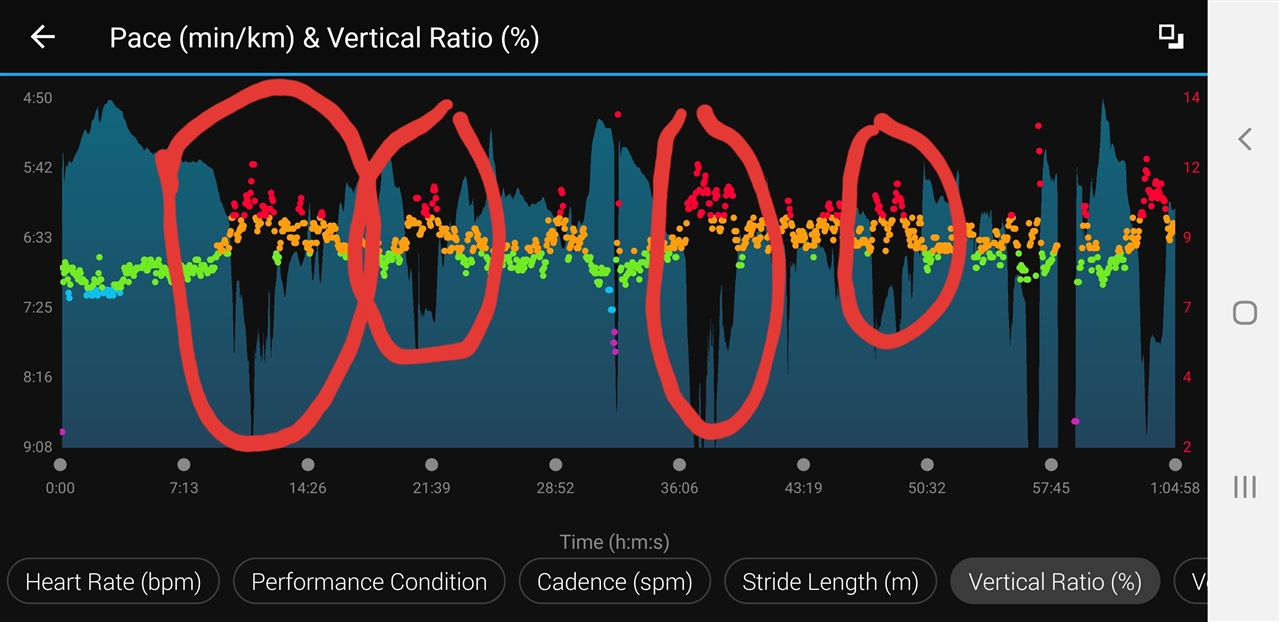It appears instant pace on my Fenix 6X Sapphire has a consistent bias towards a slower than actual pace, often by 0:30-1:00 min/mile.
That makes it more difficult to pace accurately, for example during races. It seems the bias is worse on more challenging terrain, for example on trails or under tree cover.
To understand this better I wrote a python script that parses a run activity that I export in TCX format (for easier parsing because TCX is a text based format).
Here are some examples of my script output. This is from a faster paced trail run on moderate tree covered trails:
Mile 1.00: Split: 8:42, Avg Pace: 10:04
Mile 2.00: Split: 8:52, Avg Pace: 9:22
Mile 3.00: Split: 8:37, Avg Pace: 9:17
Mile 4.00: Split: 8:04, Avg Pace: 8:31
Mile 4.53: Split: 8:03, Avg Pace: 8:03
----------
Overall pace 8:30, Avg Pace: 9:08
In this example Split time is produced every mile based on elapsed time from the beginning.
Avg Pace is produced by looking at the instant speed reported each second in each sample, averaging it over all samples of that split, and then converting that average speed to pace format (in minutes per mile). Basically Avg Pace represents the averaged result of what the watch was showing me during the run.
If anyone questions that approach, it should be OK to average the speed because it is sampled at even intervals every second (it wouldn't be OK in the case of smart recording).
As you can see there is quite a bit of discrepancy, especially in the beginning, although it gets better towards the end. Overall, after averaging, the watch reported 0:38/mile slower instant pace than what I actually ran, so there is a strong bias towards slower pace.
Here is another example - this is from a mix of road and suburban trails on more open terrain:
Mile 1.00: Split: 9:07, Avg Pace: 9:22
Mile 2.00: Split: 8:04, Avg Pace: 8:09
Mile 3.00: Split: 10:49, Avg Pace: 10:43
Mile 4.00: Split: 10:35, Avg Pace: 11:30
Mile 5.00: Split: 8:23, Avg Pace: 8:18
Mile 6.00: Split: 13:05, Avg Pace: 13:39
Mile 7.00: Split: 7:58, Avg Pace: 7:56
Mile 8.00: Split: 9:08, Avg Pace: 9:34
Mile 9.00: Split: 8:11, Avg Pace: 8:44
Mile 10.00: Split: 8:43, Avg Pace: 8:46
Mile 11.00: Split: 10:08, Avg Pace: 10:13
Mile 12.00: Split: 8:22, Avg Pace: 8:32
Mile 13.00: Split: 8:29, Avg Pace: 8:30
Mile 13.76: Split: 10:02, Avg Pace: 10:00
----------
Overall pace: 9:21, Avg Pace: 9:32
Even though this is much better overall, during some miles the discrepancy between the split times and the averaged instant pace was still up to 1 min/mile.
One more example - this is from a much slower mountainous trail run on steep terrain with a good amount of walking:
Mile 1.00: Split: 9:44, Avg Pace: 10:17
Mile 2.00: Split: 11:44, Avg Pace: 12:15
Mile 3.00: Split: 14:14, Avg Pace: 14:08
Mile 4.00: Split: 29:14, Avg Pace: 27:51
Mile 5.00: Split: 17:40, Avg Pace: 20:02
Mile 6.00: Split: 12:23, Avg Pace: 12:43
Mile 7.00: Split: 12:36, Avg Pace: 13:46
Mile 8.00: Split: 11:53, Avg Pace: 12:34
Mile 9.00: Split: 14:34, Avg Pace: 15:07
Mile 10.00: Split: 24:11, Avg Pace: 23:23
Mile 11.00: Split: 8:50, Avg Pace: 8:46
Mile 12.00: Split: 12:23, Avg Pace: 13:31
Mile 13.00: Split: 10:46, Avg Pace: 11:50
Mile 14.00: Split: 16:09, Avg Pace: 16:42
Mile 15.00: Split: 17:20, Avg Pace: 17:51
Mile 16.00: Split: 13:23, Avg Pace: 13:32
Mile 16.68: Split: 11:14, Avg Pace: 12:32
----------
Overall pace: 14:40, Avg Pace: 15:15
In this case the instant pace was faster than actual in a couple of splits, mostly in very slow ones where I walked or stopped. But the overall pattern is the same - there is a clear bias towards a slower pace.
I should add that today I installed a Rolling Average Pace Garmin IQ field that averages pace over the last 100 yards. I placed that field next to Garmin's Instant Pace and watched them side by side during an easy run. One thing was clear, every time I reached a steady pace and cruised for a while to let the rolling pace stabilize, the rolling average pace was always a bit faster than Garmin's Instant pace, which confirmed the same bias that I discovered from the post-analysis of the runs with my script.
Has anyone had similar observations?
12/05/21 EDIT: I changed the title of the post since Garmin seems to have improved the pace. It is more stable and precise than before, meaning that the values are closer together, but it is still not accurate - there is still a significant bias towards slower than actual pace



